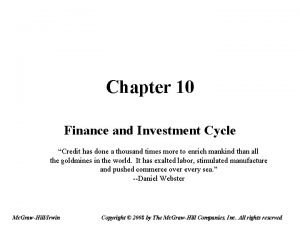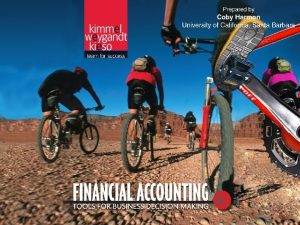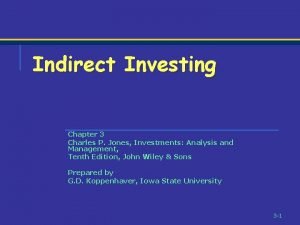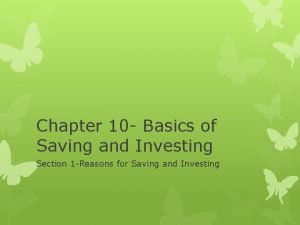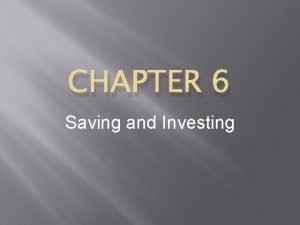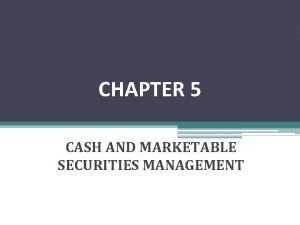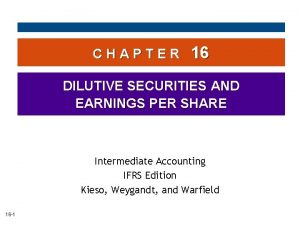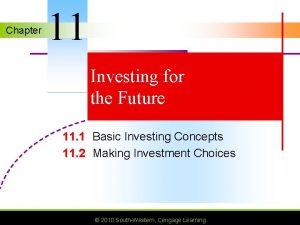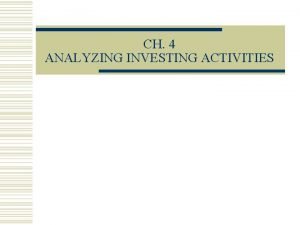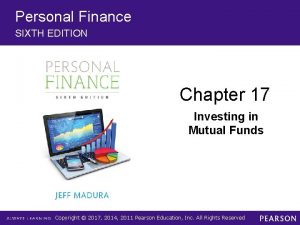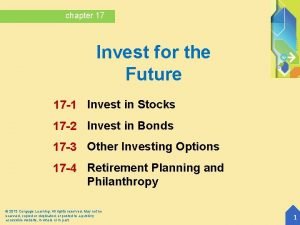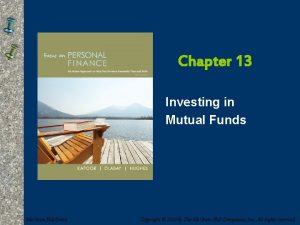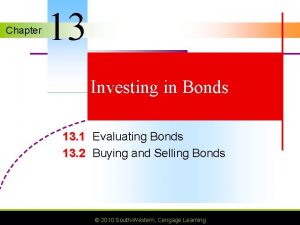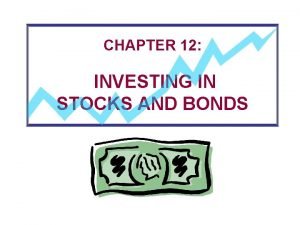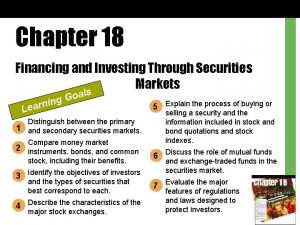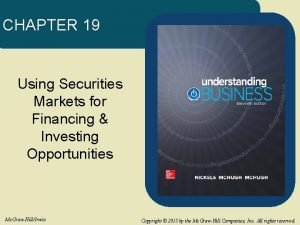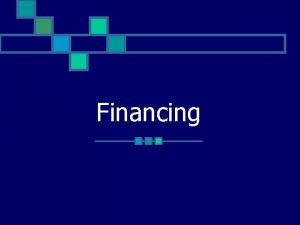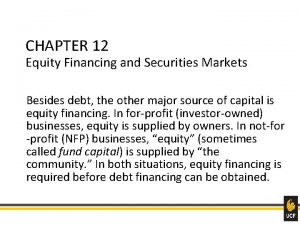Chapter 18 Financing and Investing Through Securities Markets

















- Slides: 17

>>>> Chapter 18 Financing and Investing Through Securities Markets

s l a o G g Learnin 1 2 Define finance, and explain the role of financial managers. 5 Identify sources of short-term financing for business operations. Describe the components of a financial plan and the financial planning process. 6 Discuss long-term financing options. 7 Describe mergers, acquisitions, buyouts, and divestitures. 3 Outline how organizations manage their assets. 4 Compare the two major sources of funds for a business, and explain the concept of leverage.

n o i t c n u F s s e n i s u The B e c n a n i F of • Finance – planning, obtaining, and managing the company’s funds in order to accomplish its objectives. – Maximizing overall worth – Meeting expenses – Investing in assets – Increasing profits to shareholders

e h t f o e l o The R r e g a n a M Finance • Implement the firm’s financial plan. • Determine the most appropriate source of funds. • Many CFOs are members of the board of directors.

f f o e d a r T n r u t e Risk-R The process of maximizing the wealth of the firm’s shareholders by striking the optimal balance between risk and return.

g n i n n a l P l a i c Finan • • Financial Plan – the inflows and outflows and sources of funds. Financial plans are built by answering the following questions: 1) What funds will the firm require during the planning period? 2) When will it need additional funds? 3) Where will it obtain the necessary funds? • Financial plans are based on the forecasts of costs and expected sales activities for a given period.

s t e s s A g n i g a an M Sound financial management requires assets to be managed and acquired ü What a firm owns ü Use of funds

s t e s s A ort-term Sh ü Cash ü Marketable Securities ü Accounts Receivable ü Inventory

t n e m t s e v n I l a t i Cap Analysis • Long-lived assets • Produce economic benefit for more than one year • Substantial investments • Capital Investment Analysis – Expansion: new assets – Replacement: upgrading assets

g n i g a n Ma s t e s s A l a n o i t a n r Inte • Today’s firms have facilities and assets worldwide. • Sales occur outside of the home country • International Assets require the management of activities to reduce the financial risk of exchange rates.

d n a s d n u F f o s e c Sour e r u t c u r t S l a t i p a C Debt Capital –funds obtained through borrowing. Equity Capital – investment in the firm in exchange for ownership.

l a t i p a C d n a e g a r Leve s n o i s i c e D e r u t c Stru Goal: increasing the rate of return on funds invested by borrowing funds.

d n a m r e T t r o h Mixing S s d n u F m r e T g n Lo • Short-term funds – Current liabilities – Less expensive – Volatile interest rates • Long-term funds – Long-term debt and equity – Used for long-term assets

y c i l o P d n e d i v i D • Dividends are cash payments to shareholders. • Financial Managers must make decisions regarding their dividend policy. – Should we pay a dividend? – When should it be paid?

g n i d n u F m r e t t r o h S Options ü Trade Credit ü Short-term Loans ü Commercial Paper

m r e T g n o L f o s e Sourc g n i c n a Fin ü Public Sale of Stocks and Bonds ü Private Placements ü Venture Capitalists ü Private Equity Funds ü Hedge Funds

, s n o i t i s i u q c A , s r e s e Merg r u t i t s e v i D d n a Buyouts Financial managers evaluate mergers, acquisitions, and other opportunities. – Leveraged buyouts – Divestiture • Sell-off/Spin-off
 Finance and investment cycle
Finance and investment cycle Cash flow statement indirect method
Cash flow statement indirect method Operating investing and financing activities
Operating investing and financing activities Direct investing vs indirect investing
Direct investing vs indirect investing How would you define efficient security markets
How would you define efficient security markets Chapter 10 basics of saving and investing
Chapter 10 basics of saving and investing Holding a variety of investments to reduce risk
Holding a variety of investments to reduce risk Chapter 6 saving and investing
Chapter 6 saving and investing Management of cash and marketable securities
Management of cash and marketable securities Basic and diluted eps
Basic and diluted eps Through and through conversion
Through and through conversion The spreading of risk among many types of investments.
The spreading of risk among many types of investments. Analyzing investing activities
Analyzing investing activities Chapter 17 investing in stocks
Chapter 17 investing in stocks Chapter 17 investing in stocks
Chapter 17 investing in stocks Chapter 13 investing in mutual funds
Chapter 13 investing in mutual funds Chapter 13 investing in bonds
Chapter 13 investing in bonds Chapter 12 investing in stocks
Chapter 12 investing in stocks
